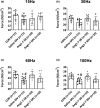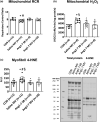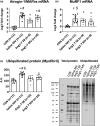Angiotensin 1-7 protects against ventilator-induced diaphragm dysfunction
- PMID: 33742769
- PMCID: PMC8301547
- DOI: 10.1111/cts.13015
Angiotensin 1-7 protects against ventilator-induced diaphragm dysfunction
Abstract
Mechanical ventilation (MV) is a life-saving instrument used to provide ventilatory support for critically ill patients and patients undergoing surgery. Unfortunately, an unintended consequence of prolonged MV is the development of inspiratory weakness due to both diaphragmatic atrophy and contractile dysfunction; this syndrome is labeled ventilator-induced diaphragm dysfunction (VIDD). VIDD is clinically important because diaphragmatic weakness is an important contributor to problems in weaning patients from MV. Investigations into the pathogenesis of VIDD reveal that oxidative stress is essential for the rapid development of VIDD as redox disturbances in diaphragm fibers promote accelerated proteolysis. Currently, no standard treatment exists to prevent VIDD and, therefore, developing a strategy to avert VIDD is vital. Guided by evidence indicating that activation of the classical axis of the renin-angiotensin system (RAS) in diaphragm fibers promotes oxidative stress and VIDD, we hypothesized that activation of the nonclassical RAS signaling pathway via angiotensin 1-7 (Ang1-7) will protect against VIDD. Using an established animal model of prolonged MV, our results disclose that infusion of Ang1-7 protects the diaphragm against MV-induced contractile dysfunction and fiber atrophy in both fast and slow muscle fibers. Further, Ang1-7 shielded diaphragm fibers against MV-induced mitochondrial damage, oxidative stress, and protease activation. Collectively, these results reveal that treatment with Ang1-7 protects against VIDD, in part, due to diminishing oxidative stress and protease activation. These important findings provide robust evidence that Ang1-7 has the therapeutic potential to protect against VIDD by preventing MV-induced contractile dysfunction and atrophy of both slow and fast muscle fibers.
© 2021 The Authors. Clinical and Translational Science published by Wiley Periodicals LLC on behalf of American Society forClinical Pharmacology and Therapeutics.
Conflict of interest statement
The authors declared no competing interests for this work.
Figures






References
-
- Powers SK, Wiggs MP, Sollanek KJ, Smuder AJ. Ventilator‐induced diaphragm dysfunction: cause and effect. Am J Physiol Regul Integr Comp Physiol. 2013;305:R464‐R477. - PubMed
-
- Dres M, Dubé B‐P, Mayaux J, et al. Coexistence and impact of limb muscle and diaphragm weakness at time of liberation from mechanical ventilation in medical intensive care unit patients. Am J Respir Crit Care Med. 2017;195:57‐66. - PubMed
-
- Agten A, Maes K, Smuder A, Powers SK, Decramer M, Gayan‐Ramirez G. N‐Acetylcysteine protects the rat diaphragm from the decreased contractility associated with controlled mechanical ventilation. Crit Care Med. 2011;39:777‐782. - PubMed
-
- Betters JL, Criswell DS, Shanely RA, et al. Trolox attenuates mechanical ventilation‐induced diaphragmatic dysfunction and proteolysis. Am J Respir Crit Care Med. 2004;170:1179‐1184. - PubMed
Publication types
MeSH terms
Substances
Grants and funding
LinkOut - more resources
Full Text Sources
Other Literature Sources
Miscellaneous

